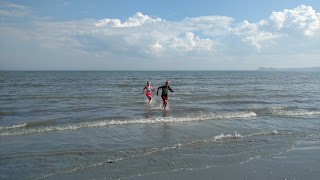After leaving Spain, we spent ten days in Marseilles, France. Since we live in apartments in most cities, we frequent nearby parks where the younger boys can burn off some steam. Their favorite playground in Marseilles (in Parc Borely) had a small, car-themed roller coaster for kids. I don't know which they enjoyed more: the roller coaster or riding the subway to get there.
On the first night in a new city, I usually walk around the neighborhood trying to find groceries for breakfast for the next day. In Marseilles the closest store was a Turkish grocer with plenty of dried fish heads and exotic olives. Fortunately for the children, they also carried peanut butter. That's a rare treat in Europe so I stocked up and we ate it with our baguettes for a few days. On the way home from the Turkish grocery, I happened across a cathedral with its stained glass windows all lit up. These kinds of random encounters are some of my favorite parts of an unplanned, spontaneous trip.
Most places in Europe have a surprisingly familiar feel. They're not much different than big cities in the States. Aside from the local language, it's often small differences that seem most memorable. For instance, sliced bread in Marseilles (and Athens too) has no heels. They're removed at the factory. At church on Sunday, everyone kisses hello instead of shaking hands: one kiss on the left cheek, then one on the right. This was the custom throughout Italy too. Alcohol is used more freely as an ingredient without any obvious labeling. So far, we've accidentally purchased alcohol while trying to buy pop, birthday cake and candy.
After Marseilles, we spent ten days each in Genoa, Florence and Rome. Our house in Genoa was above a bakery and a pizza restaurant so it always smelled delicious. Because Genoa is so hilly, they have public elevators that serve the same purpose as public buses but bring you from one part of town to another by traveling vertically. The hills also make for some nice views of the city:
Florence had some great statues and architecture. It also had many more tourists than our previous destinations. As we walked through the city, we heard more English and Chinese than we heard Italian. Since we're all early risers, we visited most sites as soon as they opened and before most tourists were awake. That worked great. When we arrived at Galleria dell'Accademia to see Michelangelo's David, we were the only ones in the room. By the time we left, the place was packed.
We also celebrated Thanksgiving in Florence. We couldn't find turkey or pie, but rotisserie chicken, dates, figs and cookies were delicious:
The age of things in Europe is always surprising for an American. For example, our house in Florence was constructed in 1470. It's been around longer than Europeans have known about our continent. I've also been impressed with the kindness of people throughout Italy. For example, on our second Sunday in Florence, it rained on us the entire time we walked to church. When we arrived, our coats were soaked. The people at church couldn't speak English, but they welcomed us with a smile, helped us out of our wet coats and gave us warm, dry sweatshirts.
Rome is always fun. I've been there a few times and always enjoy wandering around and seeing random ruins in the middle of the city. The kids have been really interested in Roman mythology for the last couple years, so it was particularly fun to explore the city with them. They'd narrate each statute with a full genealogy of the relevant gods and their myths. We were also in St Peter's Square at the same time that Pope Francis was giving a general audience, so the timing on that worked out great. Oh, and Roman broccoli is snazzy:
Athens was our last stop on this leg of the journey. Jericho accidentally left his backpack, with his laptop in the taxi from the airport. We had no luck recovering it, so my first stop in the city was to find a cheap, used laptop for him to do his school work. We ate baklava and cheesecake and visited the Acropolis. Jericho passed the sacrament in the small English-speaking branch of the Church that we attended in Athens. We also met a family at church that had just moved from Jordan, our next stop, so they gave us some pointers. All around, it's been a fun month.






























